by Luis Cotovioand Daniel George

Episode 9: The Clockwork Prisoner
(Japanese Name: 時計仕掛けの虜囚 / Tokeijikake no Ryoshuu)
Director:Nobuyushi Habara
Running time: 24m 41s (21m 00s without credits)
Opening Theme:
- (Cinema/Home Video): Uchuu Senkan Yamatoby Isao Sasaki
- (TV):Uchuu Senkan Yamatoby Project 2199
Ending Theme:
- (Cinema/Home Video): Scarlet Scarfby Isao Sasaki
- (TV): Best of My Loveby Rei Yasuda
[DG]:This episode commences with 339 days left on the time counter, which places the episode date at March 9, 2199. The events of this episode appear to take place over the course of a day or two, but that’s open to interpretation depending on how much time Analyzer actually spends training Alter in Japanese.
[LC]: As of this writing (March 2015), this episode has yet to be adapted in the official manga. Episode 13 is also missing, but since 14 has been pushed forward in the manga’s chronology, taking place before Domel arrives at Balun, its adaptation must be coming next. Still, Alter and his fellow garmilloids have been seen being analyzed in the lab and information is presumably being extracted from them.


An old analog radio tunes into the transmission of YRA – Radio Yamato. Tonight, Yuria Misaki has taken the request of crew member “Shiro Shinta” and will read an early 21st century tale named The Heart of Observer #9, written by Herbert Quain.
[LC]: Though it will have some themes reminiscent of Analyzer’s trip to planet Beemera in Episode 16 of the original series, this is the first truly original story in 2199’s run.
There are numerous plays with the number 9 throughout the episode, enforcing the connection to Analyzer, whose technical designation is AU-09. You will notice that the dial in the radio catches Radio Yamato close to frequency number 99. Also, until fairly recently I believed that the radio in these shots was in Okita’s cabin. But given the final reveal and the books behind the radio… well, we’ll get to it. Jump right to the end if you’re impatient.
The author of the obviously-fictional book being read by Misaki, Herbert Quain, is most likely a reference to the fictional author reviewed in the 1941 short story An Examination of the Work of Herbert Quain, written by Argentinian author Jorge Luis Borges and included in his anthology Ficciones


“Back when there were still no towns on Mars, a single observation station stood alone at the edge of Mare Sirenum. No one ever visited this forgotten tower, where a single, young observer lived like a lighthouse keeper. He had no name, only the number ‘9’.”
[LC]: The storybook images were drawn by Takuji Kusanagi. He drew single images which were treated with digital effects to give the impression of motion. You can see a complete postcard set featuring the artwork here.
The title of the book was meant to be The Heart of Agent 99, but since 99 is seen by many as Leiji Matsumoto’s image number, they changed it to avoid conflict. The first name for Analyzer was to be AU-99, but was changed to 09.
The screen text reads A Clockwork Parable. This, as well as the episode’s title itself is a reference to Anthony Burgess’ book A Clockwork Orange, which served as the basis for the classic movie with the same name directed by Stanley Kubrick.
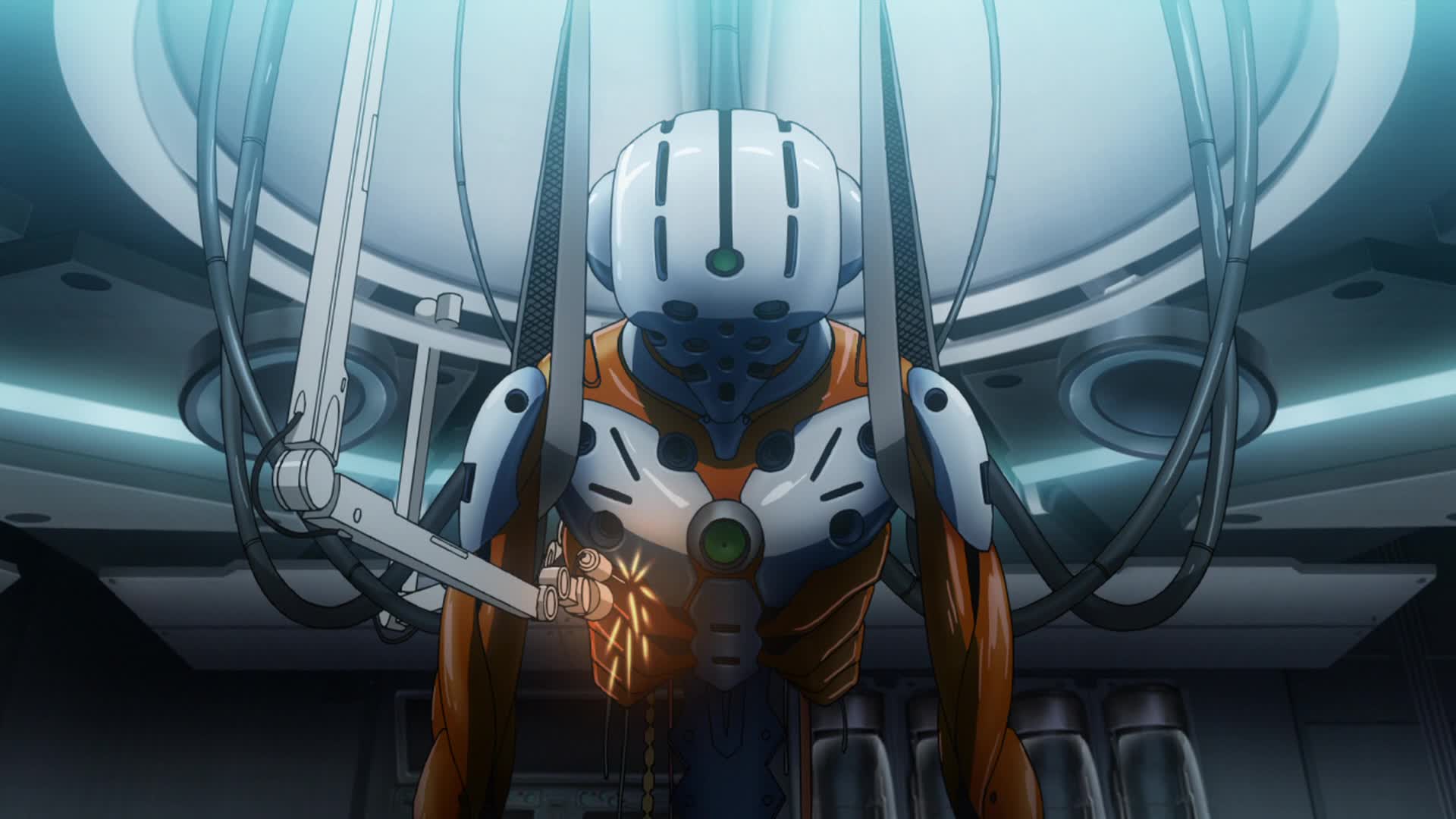

In the ship’s lab, Analyzer is busy cannibalizing parts of the two more heavily-damaged garmilloids retrieved at Enceladus, attempting to get the third one operational. This is part of a plan elaborated by Sanada and Niimi, and which we now see them explaining to captain Okita, Kodai, Yuki and Shima.
[LC]: The shot of the garmilloid hanging in the lab is reminiscent of a similar shot of the Puppet Master in the 1996 anime classic Ghost in the Shell, directed by Mamoru Oshii.
This is the first time we see the officer’s lounge, which will become a recurring set for meetings of this kind and for a tasty piece of fan service in episode 10.


Analysis of the garmilloid’s remains retrieved at Enceladus has revealed them to be automata with highly-advanced AI systems. Study of the structure of their programming has confirmed that Garmillas shares the same mathematics and understanding of physics as Earth, so communication with them might be possible, something Sanada says is of extreme importance when encountering a foreign civilization in space, especially in times of war. Okita simplifies by saying this “allows us to play shogi with the same rules.”
[LC]: Shogi, also known as Japanese chess or the Generals’ Game, is a popular two-player strategy board game. Much like chess, it has a complex set of rules and relies on strategic thinking and planning to achieve victory. Okita’s metaphor perfectly illustrates the point Sanada is trying to get across. We will get to see shogi being played later in the episode
[DG]:The mention of Earth and Garmillas sharing a common understanding of mathematics and physics could very well be a tribute to the late great Carl Sagan. In the movie adaptation of his novel Contact, Jodie Foster’s character says that “mathematics is the only truly universal language”, implying that mathematics can be a common ground between two civilizations light-years apart. Sanada’s statement in this scene echoes that sentiment.


Shima asks if they managed to obtain any other information, such as enemy positions. Sanada explains that the damage to two of the garmilloid’s data storage units was beyond repair. The third is functional but can only be accessed from a Garmillas mainframe. However, there is a way to obtain the data… To have the garmilloid itself tell them what they need.
[LC]: In an Inception-esque way, this is actually the third layer we get into. The YRA broadcast is the present, with the rest of the episode as a sort of flashback. This scene in the officer’s lounge goes back even further to explain what Analyzer is doing and when the whole project was set into motion.
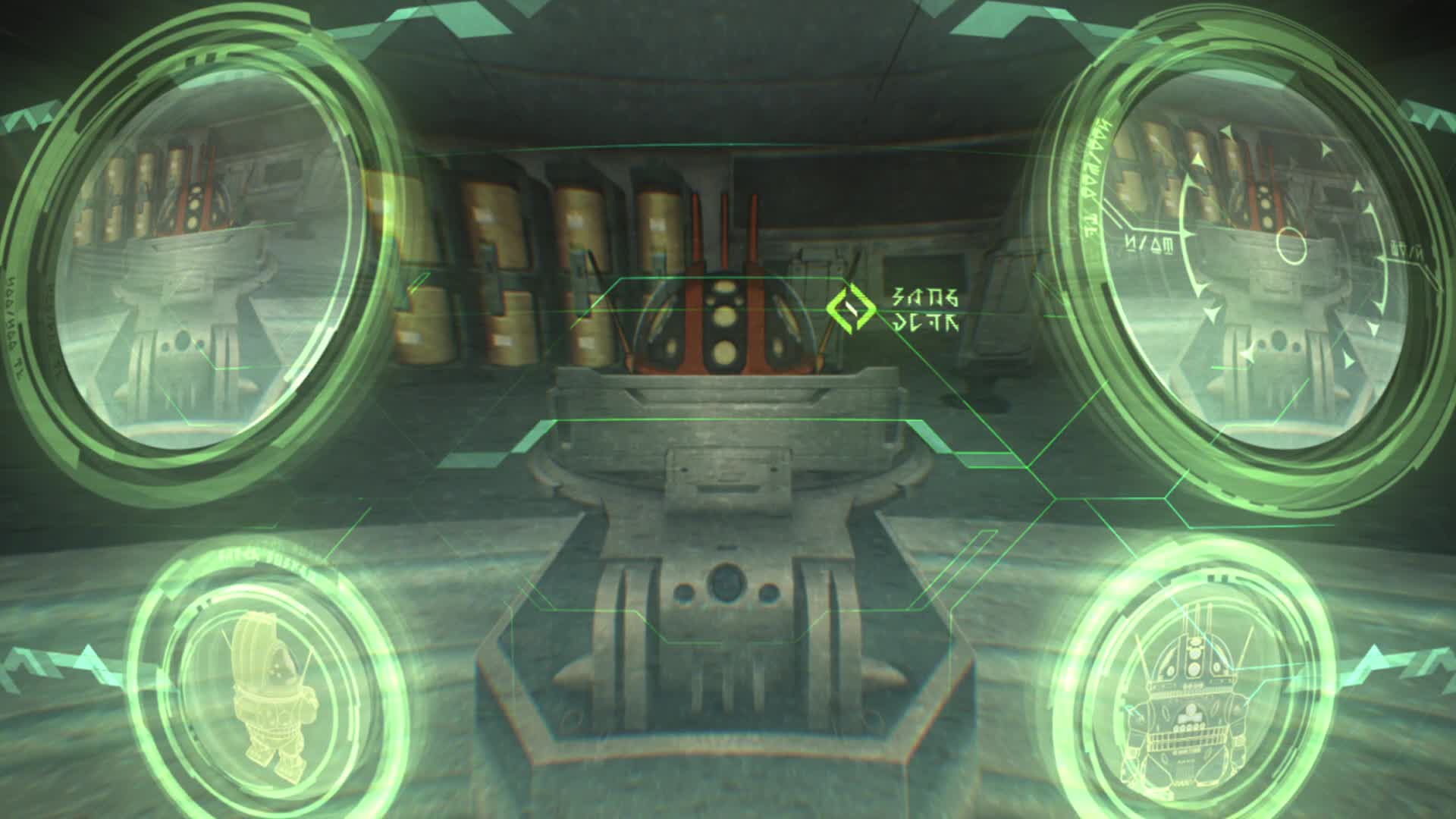

We go back to the lab where Analyzer reboots the mainframe of the designated “garmilloid Alternative.” Activation seems successful and Analyzer presents himself, first as Yamato’s sub-frame and the technical designation “Type AU09”, then by his prefered moniker, Analyzer. The garmilloid slowly utters Analyzer’s name, who proceeds to explain that he is a “rebooted, alternative version of a foreign nation’s servant android.” The designation prompts Analyzer to nickname it “Alter”, which seems to meet its approval.
[LC]: Director Nobuyoshi Habara explained that because Alter has no facial expression, much like Analyzer, they had to rely on camera angles and lighting to convey their emotions. Pay attention to the stills featuring the two robots through out this commentary.


Some time after, Yamato warps out. A scan of the surrounding space reveals no enemies in the ship’s vicinity. Analyzer requests permission to return to the lab and proceed with Alter’s reprogramming and seems quite joyful when Sanada permits it. Yuki comments on that, with Kodai responding that it’s probably due to having another machine to talk to.
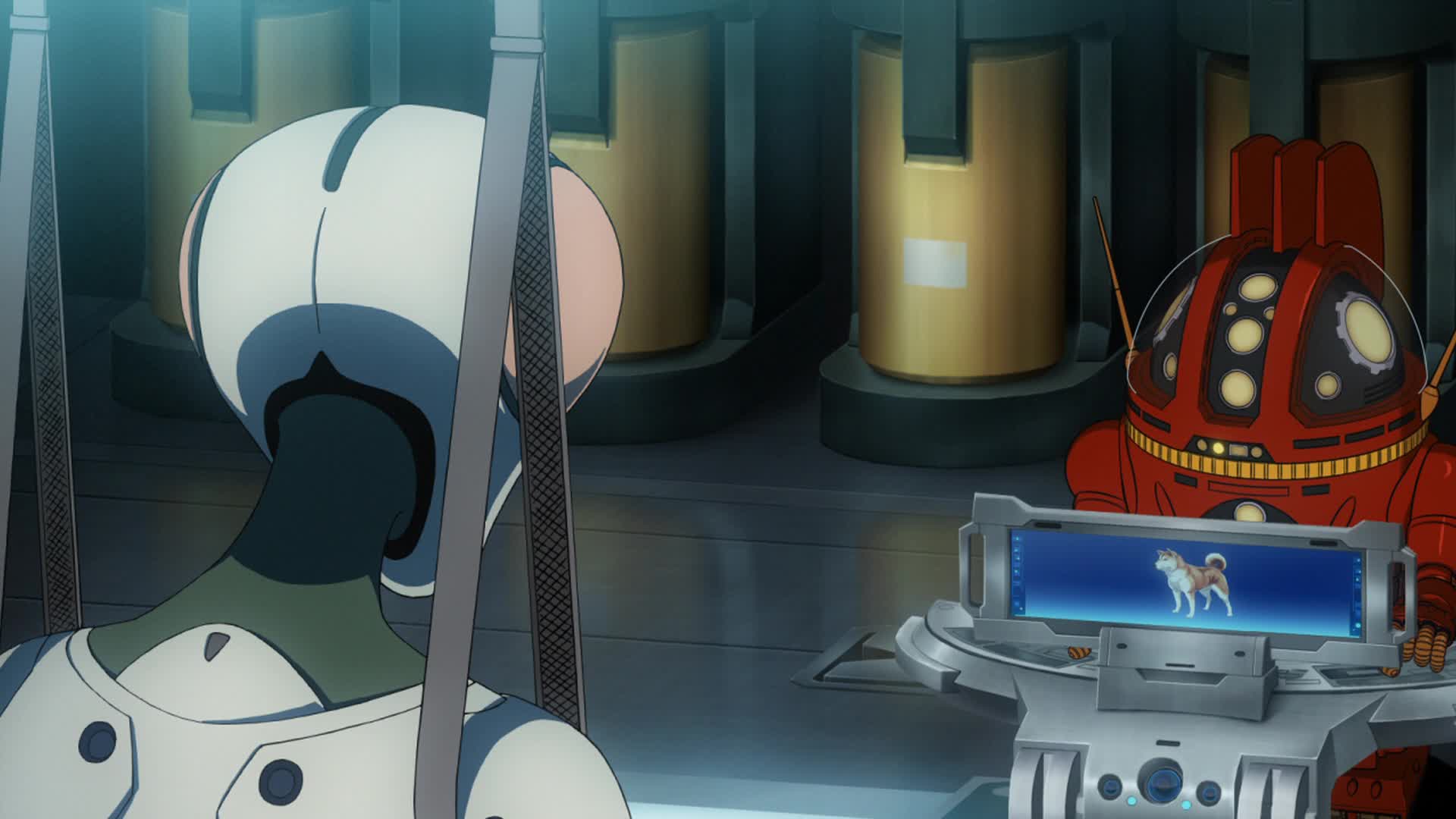

In the lab, Analyzer shows Alter a picture of a dog but Alter calls it a cat. Analyzer corrects him and clarifies that dogs are mammals, which in turn are animals. Though Alter seems to grasp these concepts, when Analyzer next shows him the picture of a cat, Alter calls it a dog, much to Analyzer’s chagrin.


Niimi comes in and jokingly asks what the two machines are secretly chatting about. Not grasping the joke, Analyzer is quick to clarify he’s teaching Alter to speak. Niimi says that since he managed to link to Alter’s OS it would be quicker to just upload the dictionary database. Analyzer says that for proper learning, just knowing the words is not enough. Alter must grasp the concepts behind them, and this requires a large number of exchanges.
[LC]: The image above right is another fine example of how they used lighting to convey emotion. You can almost hear the gears inside Alter’s head grinding, planning… eerie stuff.


Niimi also remembers that Alter isn’t allowed direct access to the ship’s network. We see Alter is paying close attention to this conversation. Inside her office, Niimi reviews the data she managed to obtain back at Gliese 581 but concludes she doesn’t have enough to know if the candidate planet can be colonized.


“One day, an old mechanical engineer named Houdin appeared at the observatory with a girl named Eve. The meeting was magical. Following the sound of a song to the sea, #9 saw a girl sitting on a rock, singing.”
[LC]: Continuing the reference to classic works of fiction, this text reads “Do Automata Dream of Electric Sheep?”, a clear reference to Phillip K. Dick’s novel Do Androids Dream of Electric Sheep?, famous for serving as the basis for the classic sci-fi movie Blade Runner, directed by Ridley Scott
The name of this master mechanic, Houdin, is a reference to Jean Eugène Robert-Houdin, who started his career as a watchmaker, later using these skills to gain notoriety as a magician and automaton-builder.


Alone in the darkened lab, Alter scans his surroundings. Finding an entry port to access the ship’s network, he extends a cable probe and successfuly links to it.
[LC]: The fact that Alter has these probes is a bit strange. Not the garmilloids per se, that makes sense. But since Alter was rebuilt aboard Yamato and must be, considered a security hazard to some extent, would they have left such a device intact? Since they don’t want him to have access to the ship’s network, leaving him the means to do so seems odd.
The only explanation that makes sense IMHO is that they simply couldn’t remove these without causing damage to the garmilloid’s systems that might render the whole exercise pointless. It could be that they simply didn’t know they were there, but given the level of tech on board Yamato and the detail of the scans we saw in the initial briefing, that is doubtful. Also, this is Sanada we’re talking about… he would know it on the spot.


Alter is immediately immersed into a world of light and swirling data. Suddenly a bird made of light appears, changing into a human form before turning around and looking at him, prompting the confused garmilloid to wonder who it might be…


“She turned and asked, ‘Who are you? What are you doing out here?”
[LC]: Habara is a master of imagery. The juxtaposition of images like these to push the story along and make the connection between the book’s story and the episode’s plot is just brilliant. He would go on to direct Episode 19, which is my personal favorite in terms of direction.
Also, who else knew exactly who this “goddess” was when they first saw the episode? Personally, I never joined the “Yuki is actually an Iscandarian” band-wagon. Sure, it was a nice romp and it kept a certain degree of mystery in order to shake things up. But making Yuki anything other than Yuki would have been problematic. So, sorry, but here’s Yurisha. As for what she is doing inside the ship’s network… well, we’ll get more on that soon enough.


Yuki walks down a dimly-lit corridor. She stops, sensing something, and looks behind toward a large, orange colored hatch that leads to the Automatic Navigation Room.
[LC]: Though it’s already been mentioned a couple of times, this is our first look at this hatch, mentioned by Hoshina in Episode 8 as the source of rumors about a ghost being on board. We can interpret the overlap of Misaki’s read of this sentence and Yuki turning around with Yurisha’s mind reaching out.
This scene with Yuki actually appears in the storyboards for Episode 3, but was crossed out and cut from that episode. A question that keeps popping up on the mind of a floor layout nerd like me is, “why is Yuki going to the Wave-Motion Gun’s room?”


Yamato sails on. Analyzer and Alter are playing shogi in the lab. Alter mentions his encounter with what he describes as “the ship’s goddess” and that she asked him who he was. When he introduced himself as “Alter”, the goddess said she wasn’t asking his name. Analyzer tries to make sense of Alter’s story and proposes Yuki or Niimi as the person Alter saw.
[LC]: The game Analyzer and Alter are playing is the aforementioned Shogi
I always find it odd that, given Alter is supposed to be kept out of the ship’s network and basically hacked into it, Analyzer doesn’t immediately ask him how he accessed the network, and report it to Sanada.


Alter then asks Analyzer if he can answer that question of who he is. Analyzer simply mutters “I am…!” before we cut to…
Shinohara and Yamamoto are aboard a Type-100 scout craft on a patrol mission. As they return to the ship, Okita gives the order to move to warp navigation at 0200. Analyzer arrives and Yuki tells him to assist with the docking operations.
[DG]: This is the first time we’ve heard of such a short turnaround between warps, which implies that this would not be an uncommon thing during the journey. For the distance they want to cover in the timeframe they have, Yamato would have to do a lot of off-screen warping during the journey. The distance they can warp with navigational accuracy is limited, so a large number of smaller jumps would be necessary. This quick turnaround also implies that there’s little or no risk of damage to the ship’s hull integrity with this frequency of warping.
[LC]: Another fine use of lighting to convey emotion, this time Analyzer’s. Also, notice the careful placement of Alter’s reflection inside Analyzer’s dials.
This is the first time they’ve used a Type-100 scout craft since Episode 1. We saw two of them inside the flooded hangar 3 in Episode 6 but they hadn’t been used until now.


[LC]: As Analyzer starts his work, we’re shown a brief shot of the dimensional compass followed by a shot of the Automatic Navigation Room hatch. Nice bit of foreshadowing. Also, a nice bit art design to make the hatch the same color as the compass.


Toyama and Iwata are on duty in hangar 3, waiting for the Type-100 to return. They’re playing a hand of poker, which Toyama is blatantly about to win when the approach alarm sounds, giving Iwata the perfect excuse to leave the table. Toyama is not happy. Alter is again plugged into the ship’s network, apparently trying to access the Automatic Navigation Room.


The Type-100 makes its approach to hangar 3 and Shinohara makes an almost flirty request to the craft’s SID (which he calls “Navi-chan”) to handle the automatic docking procedures. SID acknowledges the request and takes over, which Shinohara thanks it for. He spots Yamamoto’s less-than-amused gaze in the rearview mirror and tries to explain his friendly behavior toward the machine, claiming that if you treat them right they’ll do good work, just like anyone else. (The honorific term “chan” is a term of endearment, usually for a child or girlfriend/boyfriend.)
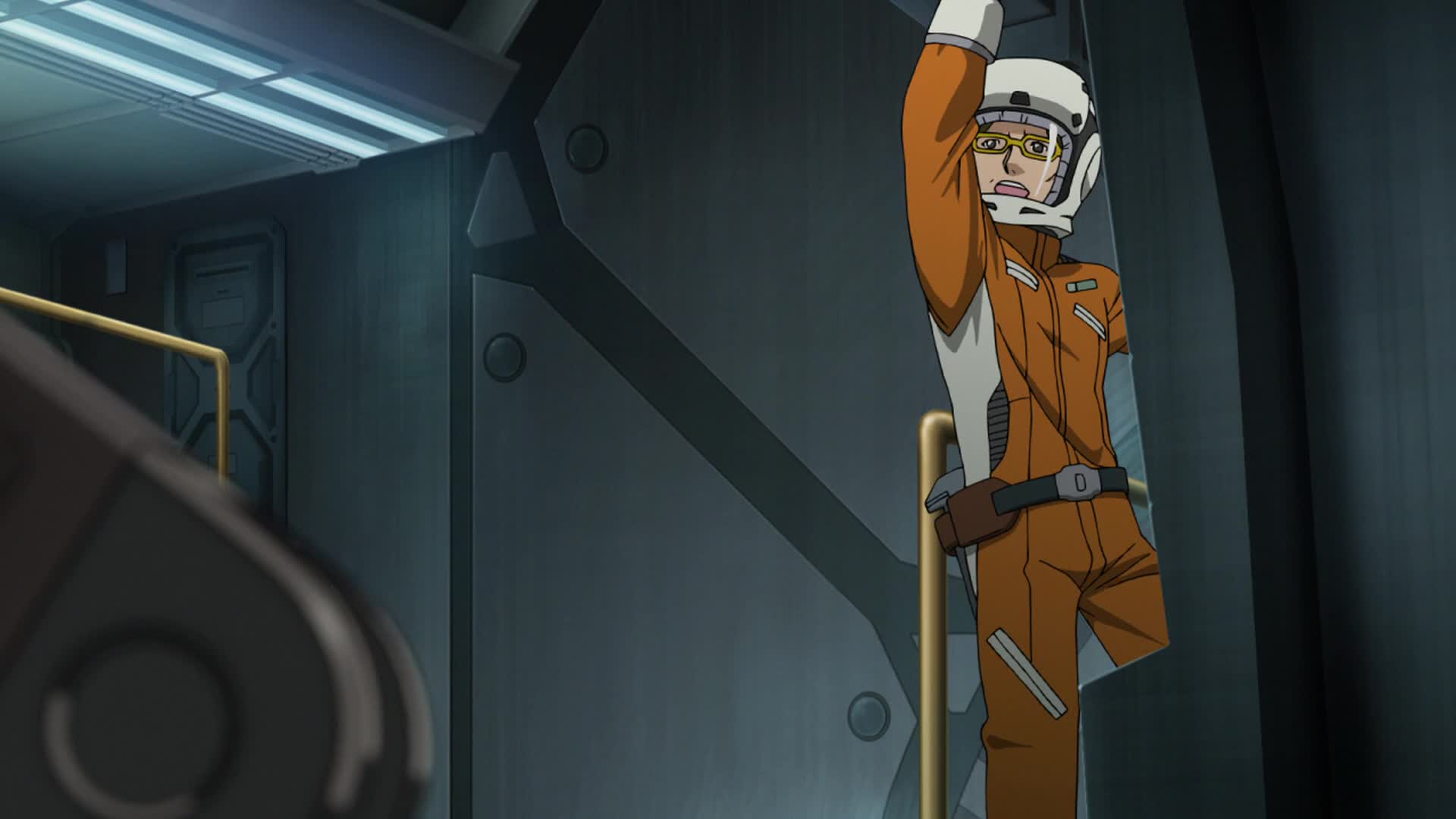

[LC]: In an episode of firsts, we get to see hangar 3 in operation, especially the systems used to retrieve support craft. Curiously enough, hangar 3 ends up as the most used and most often seen in service throughout the series. We would have to wait until Episode 20 to see a Cosmo Zero being retrieved. The Cosmo Falcon’s retrieval process wouldn’t be seen until the compilation movie A Voyage to Remember, in a scene added to the battle of the Rainbow Star Cluster.


Inside the hangar, Iwata opens the hatch while Toyama handles the crane arm. As the crane extends to attach to the support craft, Analyzer senses some sort of surge in the system. He recoils and utters Alter’s name. Sanada hears this and notices a glitch in the dimensional compass.
[LC]: The dimensional compass is a visual representation of the data being received from the Automatic Navigation Room. A holographic Yamato shows the ship’s projected course, inside a double heavy-duty glass sphere.


Iwata notices the crane arm is not moving as it should and asks Toyama if there’s an error on the control panel, but the monitor has gone down. Totally out of control, the crane abruptly swings the Type-100 into the hangar, startling Shinohara. As Analyzer attempts to fix the error, the whole system crashes.


Shinohara manages to regain some control and force the Type-100 out of the hangar, ordering SID to forcably purge the crane attachment. Unfortunately, this causes the Type-100 to spin out of control into the hangar’s gangway. Iwata jumps and pushes Toyama out of harm’s way, and the crash is only prevented thanks to Shinohara’s exceptional piloting skills.
[DG]: I like the attention to detail in this scene with the Type 100’s wingtip vernier firing and melting a section of the guard rail.


Later, in Chief Enomoto’s office, Yamamoto is tearing Iwata and Toyama a new one. The two deckhands can’t explain what happened. Kodai asks if the crane program is controlled by the mainframe. Toyama says it is, but for some reason the control monitors went down. Iwata adds that he should have shut the system down automatically but didn’t, something that never happened before.
[DG]: To me, it seems like a very serious design flaw for the ship’s mainframe to be the primary control system for the hangar retrieval equipment. Fair enough if they want to enable it to override in an emergency situation, but the primary control system should be independent and localized. Otherwise, if for whatever reason the mainframe’s network gets cut off from the hangar (which did happen for a split second), a situation like this can arise. At the very least, a manual override should be in place. There doesn’t appear to be any sort of redundant or backup system in place though.


The Chief snaps and yells that is no excuse and that his men should have been ready for this situation, that’s why humans are there to oversee operations. He apologizes to Shinohara and Yamamoto, begging their forgiveness. Shino says it’s no big deal since they got out unscathed and Akira follows suit as Kodai gives an approving smile.
[LC]: From the dialogue I get the sense that there must be some sort of manual override, but it seems Iwata and Toyama relied too much on the automatic systems and simply failed to use it properly. That’s why Chief Enomoto is so pissed off at them.


In the lab, Sanada is running a full diagnostic on Analyzer, asking him if he was talking with Alter via the ship’s network before the accident. Analyzer confirms and Sanada explains that it caused a very minor delay in the process that feeds hangar information back into the mainframe, leading to the arm malfunction.
[DG]: This suggests that either there is a major shortfall in the ship’s processing power and/or network bandwidth, or that Alter was absolutely flooding the network with his signal.
[LC]: I see two ways Alter may affect the network. Either the processing capability mentioned by Sanada in the earlier briefing is truly off the charts, or there’s some compatibility issue between Alter and the mainframe’s OS that cause the lag. Most probably the entire network wasn’t affected, just the particular system Analyzer was working on at the time, the assisted docking system for hangar 3.


Analyzer apologizes, but Sanada fears the robots’ conversations might be stressing the system. If this reoccurs, Analyzer will have to be reformatted. Analyzer prepares to object but stops, telling Sanada that would be the correct decision. Sanada proceeds and says they’ll put Alter’s analysis on hold, forbidding Analyzer to have any contact with him, either in the lab or via the ship’s network. Analyzer accepts his orders, casting a final gaze at his friend as he leaves the lab.
[LC]: Another brilliant use of lighting in this scene. When Sanada says he may need to reformat him, Analyzer stands up straight, allowing his “face” (dome) to be lit directly as he starts to object. But as he stops he lowers his upper body, with his “face” going back into shadow. This simple visual cue conveys Analyzer’s sadness perfectly.
Though not as over-the-top as the original version, 2199’s Analyzer still shows signs of humanity, at least as much as a machine can. Still, his actions throughout the episode – and this scene among them – show that, as human-like as his personality might be, this Analyzer understands and accepts his role as a machine in service of his human companions. I guess reformatting is quite an incentive to prevent skirt-flipping.


“The old man sent Eve back on board the ship, and the observer desired nothing more than to see her again. For the first time in his life, he understood loneliness. He decided to go and see Eve. He felt that this was the only way to learn who he was.”
Alone in the dark lab, Alter hangs motionless. Suddenly he looks around, detecting the remaining parts of his previous garmilloid companions. He focus on the legs that he is lacking and his probes extend toward them.


[LC]: The text reads “I, Robot.” Most will immediately recall this as the title of Isaac Asimov’s anthology of 9 short stories with the same title. Although the subject of Asimov’s stories is obviously referenced here, the plot of the episode from this point closely follows that of another short story, also named I, Robot by “Eando Binder” (pen name of authors Earl and Otto Binder).


As they walk to the main elevator, Analyzer tells Sanada something he learned from Alter, that the garmilloids are just like him. He also tells Sanada that Alter had asked him who he was and that he answered “a friend.” Though slightly surprised, Sanada considers this a great answer.
[LC]: The lighthouse on the screen in the background draws a parallel with the one in the storybook.
As for the dark corridor, the in-show rationale is that this is a way to save power on the ship, by turning some lights off. From a visual standpoint, it allows for another lighting cue, as the revelation by Analyzer is followed by the opening of the elevator door, leading him and Sanada into light, conveying hope.


In the lab, Alter has broken into the other garmilloids’ pods and used their parts to crudely rebuild his own legs. He wonders where the goddess might be. Misaki walks past the auto-pilot room hatch and, sensing something, turns around.
[LC]: This scene with Misaki duplicates the previous one with Yuki exactly. This might very well be the first time Yurisha reached out and touched Misaki. (I know how that sounds…)

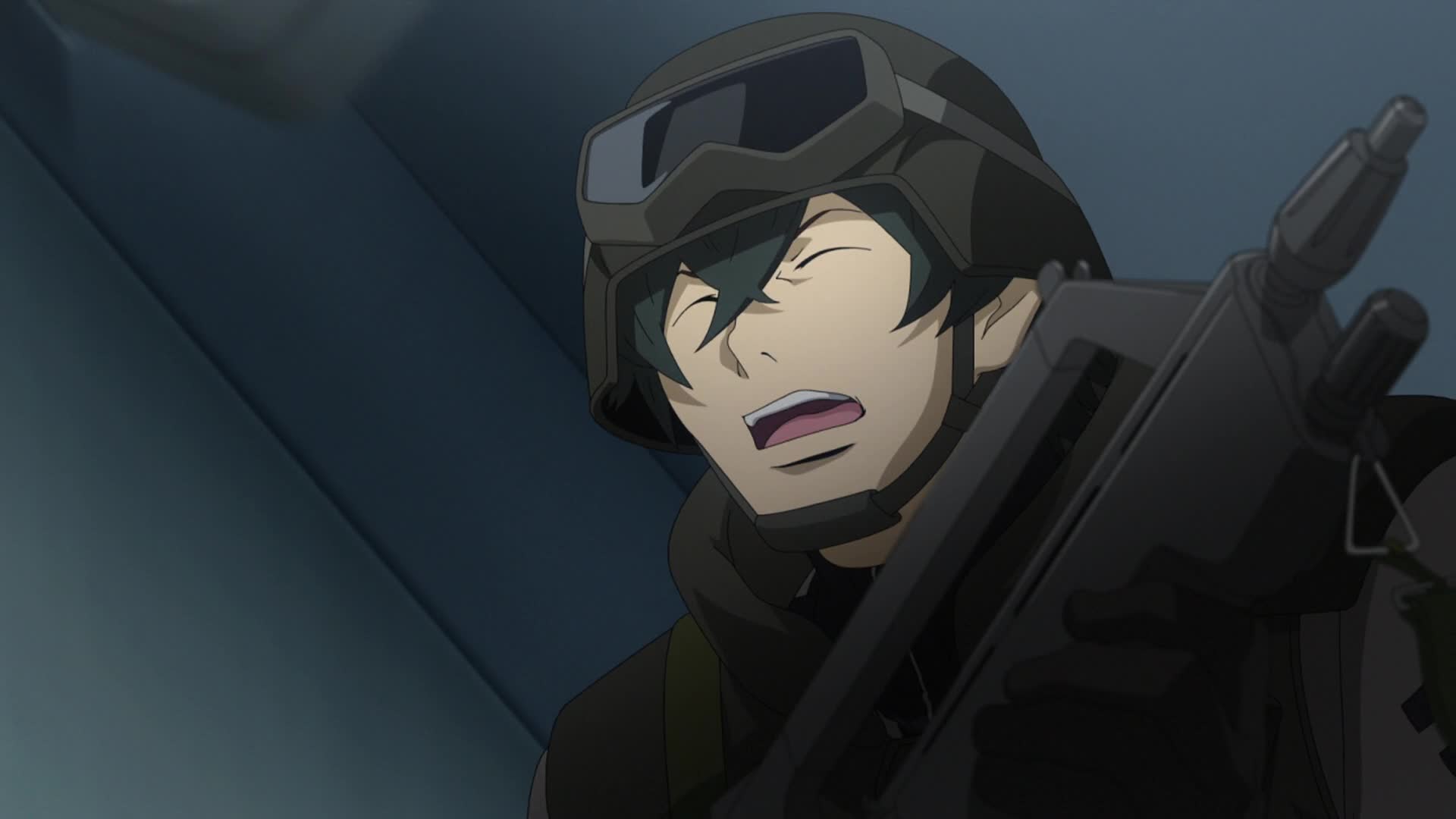
Alter breaks a door’s touchpad and hacks it open, causing alarms to sound. Still inside the elevator with Sanada, Analyzer wonders what happened. Yuki checks the security monitors and announces the lock of the analysis room has been hacked. Deducing Alter as the culprit, Okita mobilizes the security team.
[LC]: Finally, after eight and a half episodes hanging around and looking creepy, Ito is given something to do. 😀 This is also the first time we see more security officers besides Ito and Hoshina. Click here for a rundown of the security team.


The security force arms itself with Ito authorizing the use of deadly force if necessary. Alter limps through the ship’s corridors as warnings sound through the PA system. He runs into two security officers and quickly scans them, detecting their weapons. The light in his chest shifts from green to red as he turns and runs away.


While the officers give chase, Analyzer tells Sanada that Alter wanted to know who he was and thinks that once he finds the ship’s goddess, he will learn. Sanada is curious about the term “goddess” which Analyzer says is someone Alter believes to be the goddess of the ship. He also learned another important thing about the garmilloids. Cut to Hoshina and his men catching up to Alter who, finding himself between a sealed bulkhead and the security force, jumps into the air vents.


Hoshina hesitates to open fire, but as Alter jumps out of sight, several shots barely miss him. Hoshina looks behind and sees Ito with a furious gaze in his eyes. On the bridge, Okita asks where the garmilloid is. Yuki reports that he is heading toward the ship’s bow, using the deck 2 ducts.
[LC]: Ito’s quick to pull the trigger. This shows us he is truly calm under pressure. If there were still any doubts about how dangerous he is, they should be gone by now.


Hoshina concludes they’re heading to the mysterious sealed room, which Ito tells him contains the automatic guidance systems that are taking them to Iscandar. That must be the enemy’s objective. Alter drops from the ceiling a few yards from them and Ito says they mustn’t allow the garmilloid to reach that room – to destroy it if necessary. Alter scurries along trying to avoid the soldiers’ fire as he utters “Enemy… Terror… Being… Goddess!”
[LC]: The way Alter moves in this scene is reminiscent of the way one of the strike droids moves in 1987’s OVA Black Magic M-66.


Spotting an access port in a nearby room, he uses his probe to hack it open and seal it shut behind him. Yuki announces that the garmilloid is inside the loading room for gun turret number 2.
[LC]: The text reads “Flow My Tears, the Automata Said”, a reference to Phillip K. Dick’s Flow My Tears, the Policeman Said.


Hoshina can’t get the access door open. Ito calls the bridge to get it done, but Aihara tells him the security systems were infiltrated and the room is locked from the inside, requiring some time to override it. Ito is not pleased. Analyzer and Sanada arrive on the scene with the robot asking them to stand by. Ito says his timing was perfect and tells him to open the door.
[LC]: Another entry in the “nonsensical pieces of onscreen information” series, here we see a clock which reads “Mission Time” with the readout “36 1:01:01:722”. This isn’t as nonsensical as other screen info we’ve seen, since (as surmised by Daniel at the top) this episode starts 26 days into the mission. If we assume that point is when Sanada briefed the other officers about his plans for Alter, the garmilloid’s reassembly and other events so far would have spread across ten days, which seems plausible. What makes this screen enter the “nonsensical series” is not the clock itself but the fact that there’s a smaller clock in the screen below it that seems to be counting the time since Alter’s breakout – and it perfectly matches the “Mission Time” clock. Alter should get a medal for “extreme perfect timing.” XD

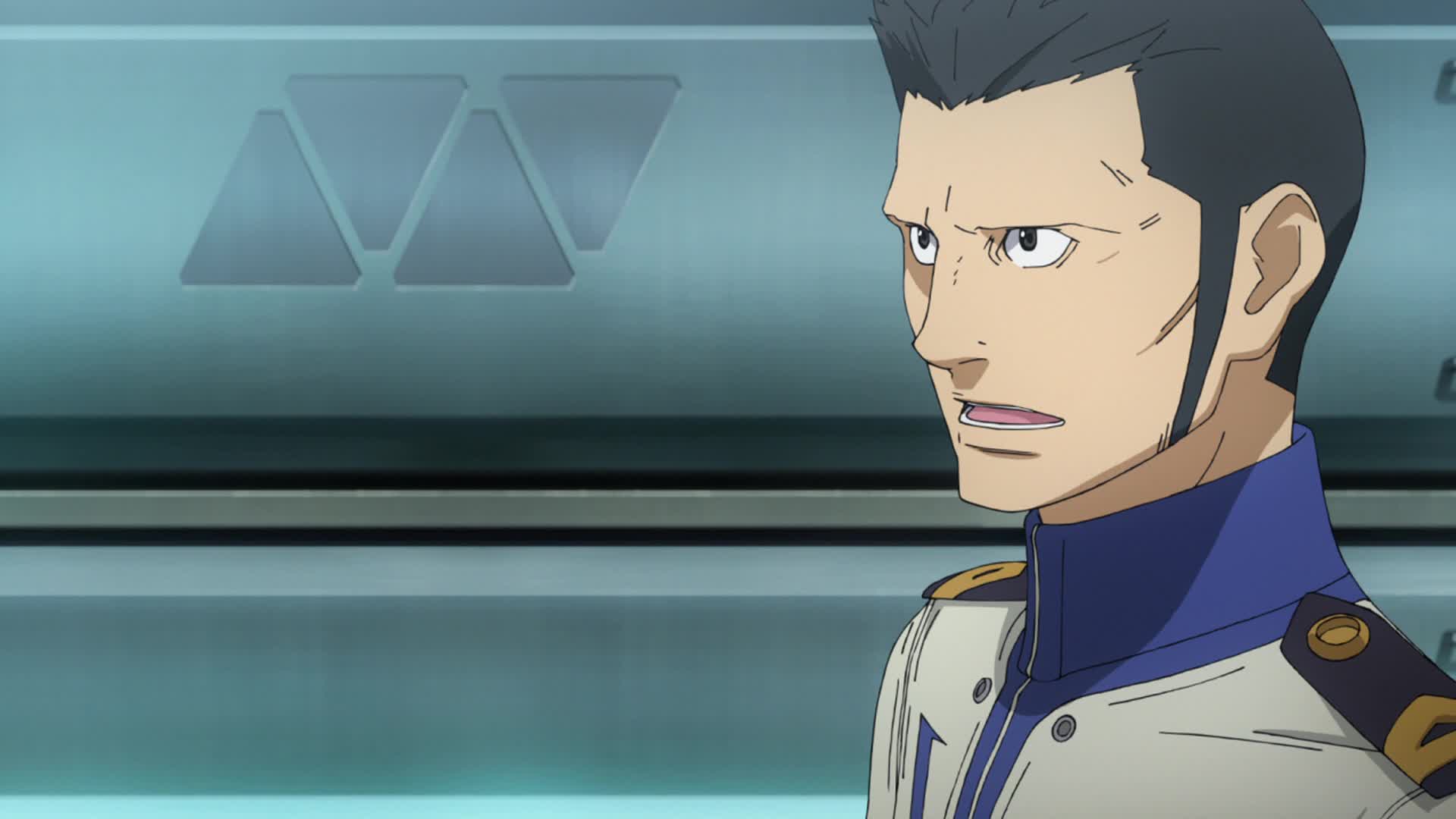
Before opening the door, Analyzer asks that they put their guns away. He doesn’t want Alter to think they’re enemies. Ito is puzzled and affirms that they are enemies. Misaki arrives and asks him if he would kill an unresisting prisoner. Ito finds the idea preposterous, seeing Alter not as a prisoner but as nothing more than a robot. Misaki says that if it has a heart, even a machine should be treated as a prisoner. Ito dismisses the idea while Hoshina is curious at the notion, though he recalls Sanada had described it as a simple automaton.


Sanada says it’s true the garmilloids are automata that function by running highly complex programs. Ito interrupts, saying machines are just machines. But Sanada proceeds, explaining that no one can be sure our own brains aren’t also automata that function via parallel processing, and it can’t be proven that mechanical processing circuitry cannot give rise to a consciousness like our own.
[LC]: One of the big questions surrounding 2199’s updated story was wether Sanada would still be a cyborg, as revealed in the original series’ Episode 18. Though it was a cool gimmick back in 1974, walking around with bionic limbs rigged with explosives would seem a bit off these days. On the other hand, 2199’s Sanada is a lot colder and robot-like than the original (though admittedly cool as hell).


Ito scoffs at the notion, calling it an “interesting story.” Analyzer finally bypasses the security system and opens the door, allowing the security team access to the room. Even though Sanada tells them to keep their weapons down and Ito seems compliant, once inside the room he is quick to train it on the target… which is no longer there. Alter has once again accessed the ship’s duct system. Ito is getting really pissed.


Outside, Hoshina has to hold up a collapsing Misaki. Analyzer alerts Sanada to the necessity of shutting Alter down immediately. When Ito asks why, Sanada explains that Alter may “commit suicide.” Analyzer states that garmilloids are programmed to self-destruct if isolated and surrounded by enemies. As Sanada and Analyzer leave, Ito asks the XO if he truly believes the garmilloid to have a heart. Sanada dryly responds that for him it remains unclear if even Ito has one, that he could just be simulating a human.
[LC]: Yurisha’s hold on Misaki seems to fade rather quickly and take its toll on the young officer. The following episode will see this “symbiosis” evolve.
A curious detail in the manga, which must be taken with a grain of salt depending on how canonical you assume it to be, concerns Ito and puts this exchange in a different perspective. In the adaptation of Episode 14, we’re shown a lot more background stories than in the episode itself. One of them is how Ito became crippled aboard a Murasame-class destroyer when a console exploded and ripped his hands apart. Later, he wakes up in a hospital with bionic hands, thus taking Sanada’s place as the ship’s “bionic man.” This shines a whole new light on Ito’s sometimes extremist views about aliens and machines, though his injuries aren’t enough justification for the level of bigotry he’ll display further ahead (or any other level, for that matter).

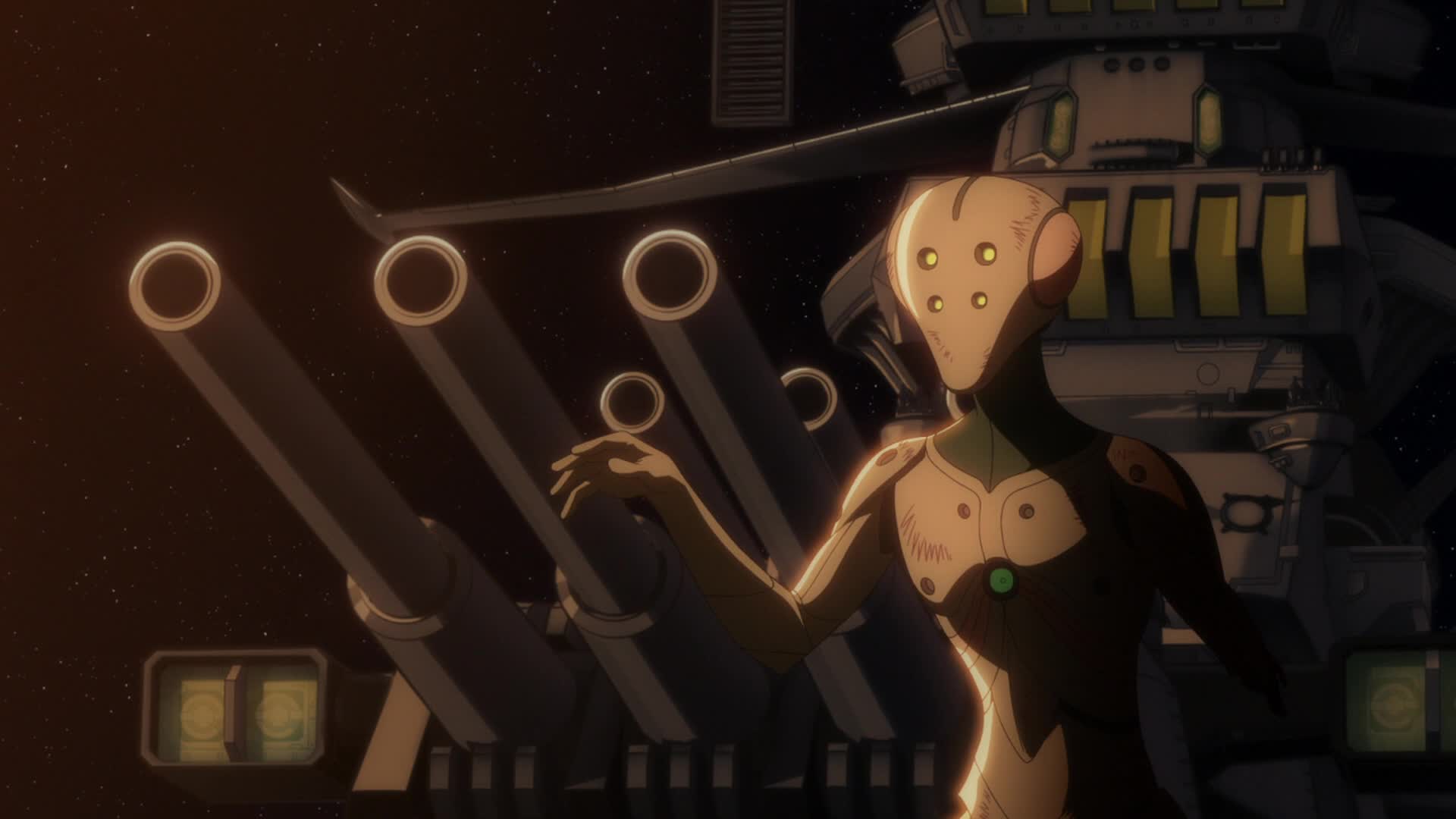
Yuki tracks Alter to the upper deck, outside the ship. Okita reiterates the need to stop him from reaching the automatic pilot room, destroying it if they must. Damaged and shaken, Alter walks past gun turret one. He stops. Analyzer stands before him. Under the light of a red star, the two machines slowly approach each other, watched by Kodai and the others from the main bridge.


After a brief pause, Alter reaches out for Analyzer. At that point, his damaged legs break apart and he falls forward. Analyzer reaches for Alter’s hand. Upon contact, Analyzer immediately hacks Alter’s system.
[LC]: The shots of Analyzer and Alter in front of the red star evoke the image of Kodai and Dessler’s encounter at the end of The New Voyage


As his systems shut down, Alter utters the words, “dog… cat… being… goddess… death… fr—i—en—d……”, just before the insides of his head turn into mush, splattering service fluids over Analyzer.
[LC]: At the time of my first viewing, I was puzzled by this scene, since I believed someone had shot Alter – but no one was shown. It was only later that I realized it was an internal thing. Whether it was a self-destruct mechanism or the result of an energy surge caused by Analyzer hacking his mainframe, it was never explained. But given what Sanada reports next, I’d go with the latter.


Analyzer reports the garmilloid Alternative has been shut down, and that its mainframe has been reformatted and can’t be rebooted. Sanada orders him to retrieve its task log, which Analyzer extracts from Alter’s chest before jettisoning the garmilloid’s lifeless husk. He stands there motionless, watching as his friend’s body floats away.


Later, Sanada has completed his analysis of the retrieved data and reports no evidence of any activated booby trap. Analyzer concludes, backed by Sanada, that in the end Alter still believed that he still had at least one friend aboard. This is little comfort to Analyzer, who looks silently at the image of a dog on the screen…


“Eve’s skin was peeled away, her joints torn off, revealing a body of gears and silicon. From the tower’s window, #9 watched her sink into the Mare Sirenum.”
We see Alter’s body floating in space while Analyzer stands quietly in the rear observation dome looking at the red star as Yamato flies away.

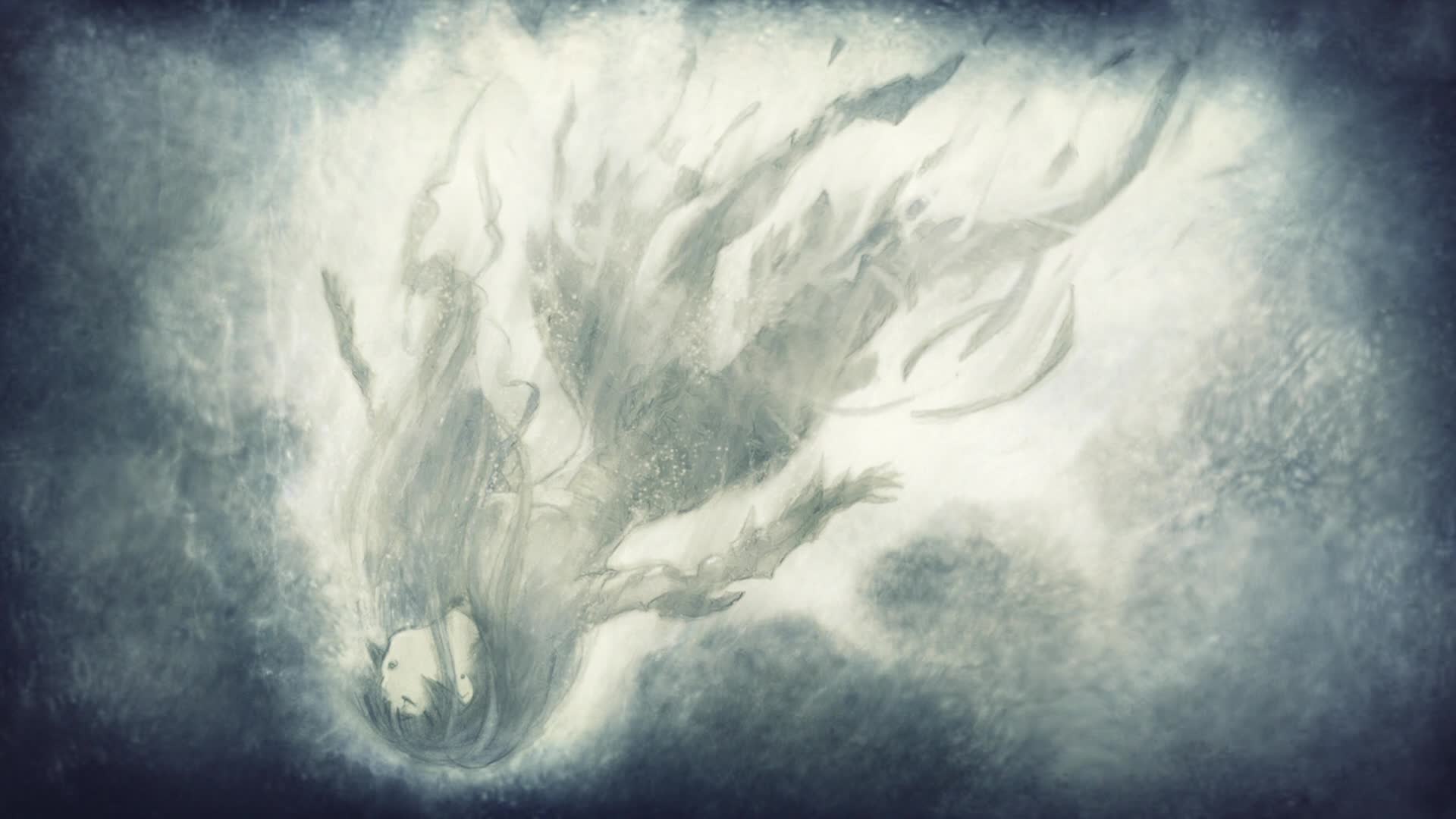
“‘I no longer feel pity for that doll. Because I know that I am also one, created by Houdin,’ he thought to himself, alone in his small room in the observation station. Wether that beautiful doll did or did not have a heart, it didn’t matter to him. As he thought this, as well… ‘The fact that I have a heart is a secret that belongs only to me.'”
[LC]: The shot of Analyzer in the rear observation dome is a final homage to the original Episode 16, where Analyzer looks at Beemera as Yamato flies away.


As we see Misaki reading the book’s final paragraph, we see a copy of the book on a table. Lying in bed beside it is Sanada, who rolls over and turns the light off for the night.
[LC]: This final reveal that “Shiro Shinta,” the person who requested the reading, is none other than Sanada himself is quite telling. We spend the whole episode thinking that the book’s story intertwines with Analyzer and, to an extent it does. But in the end it’s much more about Sanada himself, a man with a cold and analytic mind, which is the side of him most in the crew know. But as we’ll see in future installments, if we didn’t know it already, he’s one of the most heartful persons onboard.
[DG]: Is it really that much of a reveal though? Sanada used his actual first name, and he’s the only character we know of in the series with that name.


[LC]: Going back to my initial comment about the old analog radio, the titles of the books behind it are, from left to right: The World of Theoretical Physics by E.P. Dawkins, Buchinski Wave Equation Hypothesis by Patrick Fisher, Fusion Reactor Specifications, Basis of Noncommunicative Geometry, Applied Quantum Mechanics, Randomized Algorithm, What Are Tachyon Particles ?, Ramanujan’s Theorem, Plane World and Extra Dimensions, An Overview of Algebra and The Homecoming by Sakutarō Hagiwara
Most seem to have rather generic titles and no actual works or authors in this list were found in our research, except for the last one. Funny that among all these books about science, the one that has a correspondence to the real world is the work of a poet. How Sanada – the cold, automaton-like man of science – became involved with poetry will be a major plot in a future episode. Again, foreshadowing is everything.
This episode’s original TV broadcast was the first to feature Rei Yasuda’s end-title song Best Of My Love, illustrated with a new scroll by Kia Asamiya. Click here to see a full rendition of the clean scroll.
PREVIEW:
Yamato plunges through a dimensional gap into a ship’s graveyard. A cruel space, devoid of life. And there, the shadow of an enemy ship appears. Will they work together or against one other? Will men be able to work together, rather than wait for death?
Next time: Graveyard of the Universe.
There are 325 days left before humanity becomes extinct.

RELATED LINKS:
Official website of Yamato 2199
Yamato Crewwebsite
Chapter 3 Trailer
Episode 9 credits
Screenplay: Sadayuki Murai
Storyboard: Mitsuru Hongo, Nobuyoshi Habara
Director: Nobuyoshi Habara
Animation Director: Seiji Kishimoto
Chief Animation Director: Akihisa Maeda
Mecha Chief Animation Director: Masanori Nishii
Series credits
Original Story: Yoshinobu Nishizaki
Planning: Shoji Nishizaki, Mitsuhisa Ishikawa, Satoshi Kono
Original Character Design: Nobuteru Yuuki
Guest Character/Prop Design: Shinichi Yamaoka
Mecha Design: Junichiro Tamamori, Yasushi Ishizu, Kiminori Yamane, Yutaka Izubuchi
Set Design: Takeshi Takakura, Makoto Kobayashi, Takashi Watanabe
Concept Design Support: Kazutaka Miyatake
Chief Director: Akihiro Enomoto
Director of Photography: Takashi Aoki
Art Director: Minoru Maeda
Video Editing: Emi Onodera
Color Correction: Rumiko Suzushiro
Music: Akira Miyagawa, Hiroshi Miyagawa
Sound Director: Tomohiro Yoshida
Sound Effects: Mitsuru Kashiwabara
Chief Mecha Animation Director: Masanori Nishii
CG Director: Takashi Imanishi
General Director: Yutaka Izubuchi
Production: Space Battleship Yamato Production Committee
Production IG, Bandai Visual, Xebec, Bandai, Bandai Namco Games, Voyager Entertainment,
Tohoku Shinsha Film Corporation, Shochiku Co. Ltd., OLM, Lantis Co. Ltd.

Masterful analysis. My two bits: “alter” means “other” in Latin, as in “alter ego” (the other me).